Have you ever wondered how structures like paved paths, patios or ponds stay strong and secure? Do you ever daydream about having a lush, fragrant lawn to kick back on during a sunny day? If your current outdoor situation includes soggy structures, waterlogged messes, and an ongoing battle against stubborn weeds, listen up and don’t lose hope, as there is a way to bring back that beautiful garden. The secret weapon? Landscaping materials.
These materials aren’t just about creating a stable surface; they’re like the superheroes of your outdoor space, tackling everything from unruly roots to hours spent weeding. Picture this – from driveways to patios, and even flower beds, membranes come to the rescue, preventing floods and keeping things in check.
Now, let’s talk about the dizzying array of options out there. Woven, non-woven – what’s the deal? Weed control versus root control – a bit confusing, right? That’s where our buyer’s guide to landscaping fabrics swoops in to save the day. We’re here to unravel the info and help you find the perfect membrane for your landscaping project.
 Table of contents
Table of contents
- What are landscaping fabrics?
- What are the benefits of landscaping fabrics?
- Which landscaping membrane do I need?
- Do I need a woven or non-woven geotextile?
- How easy is it to fit landscaping membrane?
What are landscaping fabrics?
You can typically break down landscaping fabrics into categories, including weed control membranes and geotextiles.
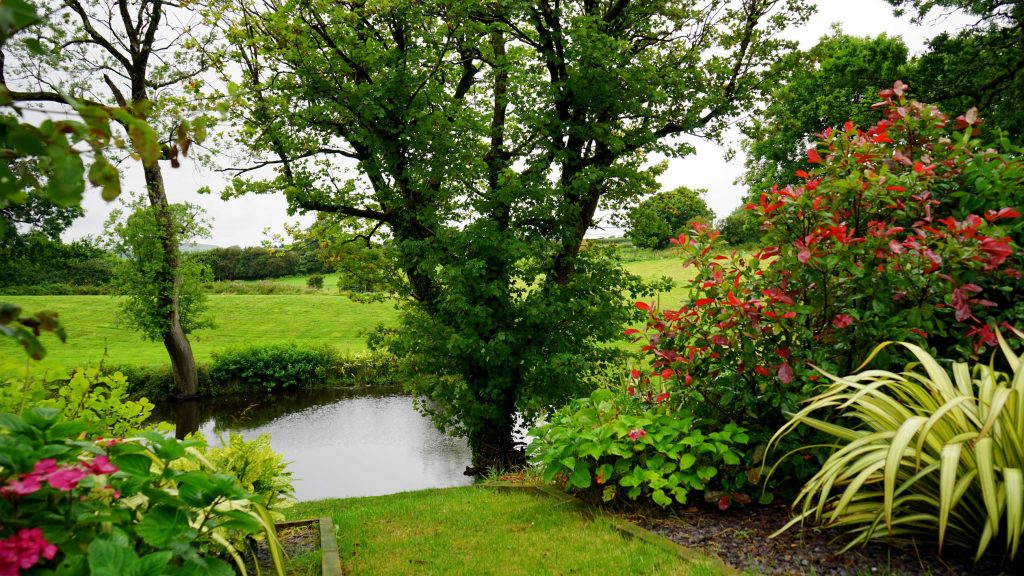
Weed control fabrics
A weed control fabric is ideal for preventing weeds from growing anywhere they’re not wanted. There are a few that are for specific placement in areas like:
- Flower beds
- Under lawns
- Driveways
- Decking or patios
With that said, there are universal options and some with special applications. For example, specialist fabrics like the DuPont Plantex Root Barrier are suitable for vertical applications. This is to stop aggressive roots like bamboo from invading other garden structures.
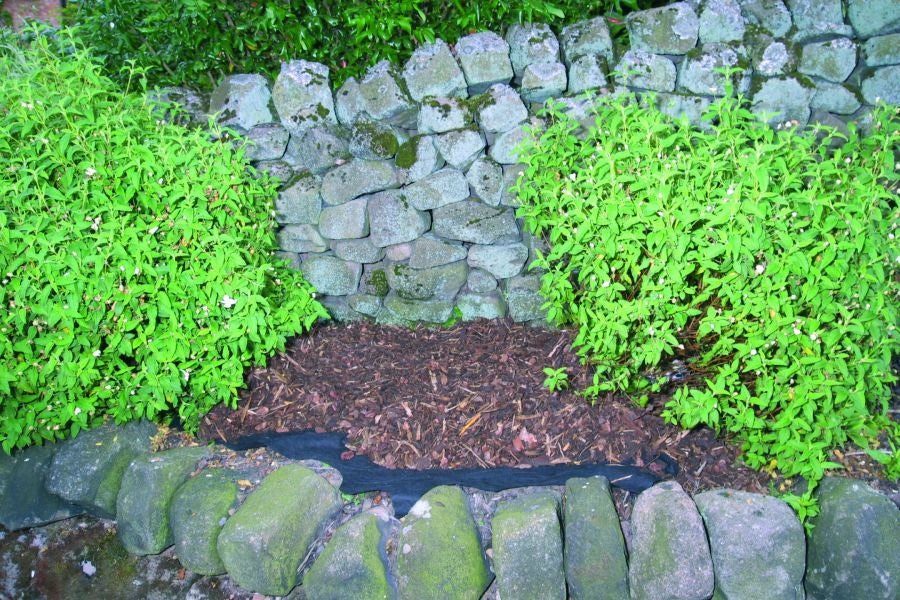
Geotextiles
You can also use a geotextile to control weeds, but the design is much more heavy-duty. As such, their use is more common in ground engineering projects like roads or driveways, improving strength, stability and drainage capabilities.
For gardens, geotextiles work well under hardscaping projects like patios, paths or decking. Their role is vital for keeping different parts of the soil from mixing – a common cause of weakened garden structures.
Geotextiles are also used in various drainage projects, soakaways and land drains for example, to prevent silt or debris entering the system.
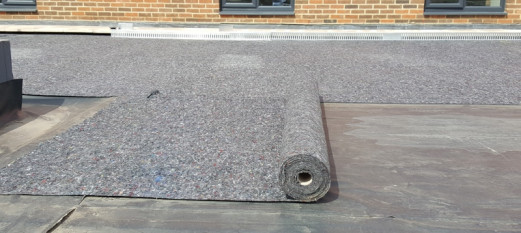
What are the benefits of landscaping fabrics?
Still not convinced whether landscaping fabric is suitable for your garden project? Well, here’s a list of what membranes can do for you.
They can prevent waterlogging
Anywhere with flat land will likely have compact soil or a high water table, so installing a suitable drainage system and keeping it maintained is no contest.
Without a suitable drainage system, water could collect on the surface. This could lead to flooded paths and patios, expensive plants drowning beneath the excess water, and your lawn turning into a muddy bog.
If you know your lawn is prone to waterlogging, regardless of whether it’s all or part of the area, a drainage solution is the way to go. Soakaway crates wrapped in non-woven geotextile membranes (such as Spudulica Heavy Duty Soakaway Wrap Fabric) are exceptionally useful. You can see an example of this below, where it is part of a domestic soakaway system.
As for flower beds or any borning at risk of getting soggy in heavy rain, you use any permeable weed control membrane. This will help drain excess water away from the plants, keeping them looking great and in a healthy state.
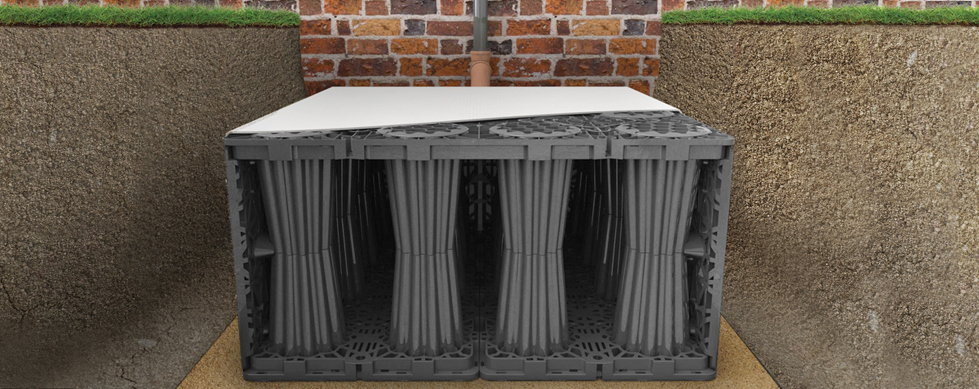
They help stop soil erosion
Membranes can stabilise loose soil, which stops it from eroding due to weather. Two of the most common areas vulnerable to soil erosion are slopes and embankments, which are extremely dangerous. The reason is moving soil affects the growth of grass or plants but can also destabilise the slope. So, walking on that patch of land can risk a harsh accident occurring if not dealt with soon.
They can stop soil and gravel from moving around too much
Thinking about adding gravel to your driveway? Consider this – a robust, woven geotextile membrane. Why? Well, it acts as a protective layer for your stones, keeping them neatly confined and preventing any ambitious escape onto the road. As for excess water, these geotextiles allow the liquid to pass through while expertly separating and stabilizing the aggregate within.
That’s not all, as the beauty of this geotextile solution goes beyond just containment. It transforms your gravel paths and soil into a breeze to walk or drive on, making your outdoor experience smoother and more enjoyable. So, if you’re aiming for a gravel haven that stays in place and feels fantastic underfoot or tire, the woven geotextile membrane is your go-to accomplice.
They can keep different parts of your soil separate
Pesky potholes on your driveway and sagging areas in your lawn can be an aesthetic pain as well as an impractical one. When heavy use compacts the soil, it can lead to a host of unsightly issues. Fear not, as geotextiles are, once again, a great way to prevent this.
These nifty materials do more than absorb and distribute the weight of heavy loads. They work wonders in keeping different sections of soil apart, preventing the dreaded sinking and rutting caused by aggregates settling into the ground beneath. The result is less hassle of compacted soil and a smoother, more resilient outdoor space.
They can save you from hours of gardening
If you’re tired of the constant weed battles in your beds and borders, weed control fabrics like that of DuPont or ProWeed can do wonders. Just lay the fabric on the ground beneath the topsoil and its structure. This will allow air, water and nutrients to pass through while guarding against persistent weeds trying to emerge from dormant seeds below.
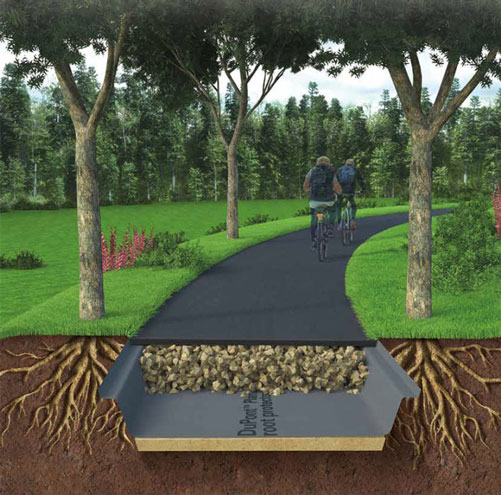
They extend life to your paved paths or patios
Surface cracking poses a significant challenge in paving, presenting both aesthetic concerns and the potential for water infiltration, leading to additional complications.
Geotextiles such as Wallbarn, Groundtex, or TCS offer a practical solution to mitigate cracking issues. These materials are crucial for reinforcement between the paving and the underlying soil. In addition to establishing a formidable moisture barrier, geotextiles absorb and disperse stress, effectively halting the propagation of unsightly cracks.
They help you be kind to the environment
By affecting the source using a weed control membrane, you’re opting for an effective strategy that minimises the reliance on aggressive chemicals and herbicides required to maintain your garden’s lush and pristine appearance. This proactive approach contributes to the aesthetics of your outdoor space, plus it aligns with environmentally conscious practices by reducing the use of potentially harmful substances. Enhance the health and beauty of your garden while minimising the environmental impact using a weed control membrane.
They can create a green roof
Employing a geotextile membrane, such as the one offered by Alumasc, proves it is vital for establishing an appealing and low-maintenance green roof. This specialized fabric operates on a dual front, facilitating surface water drainage while being a robust barrier against root penetration through the roof.
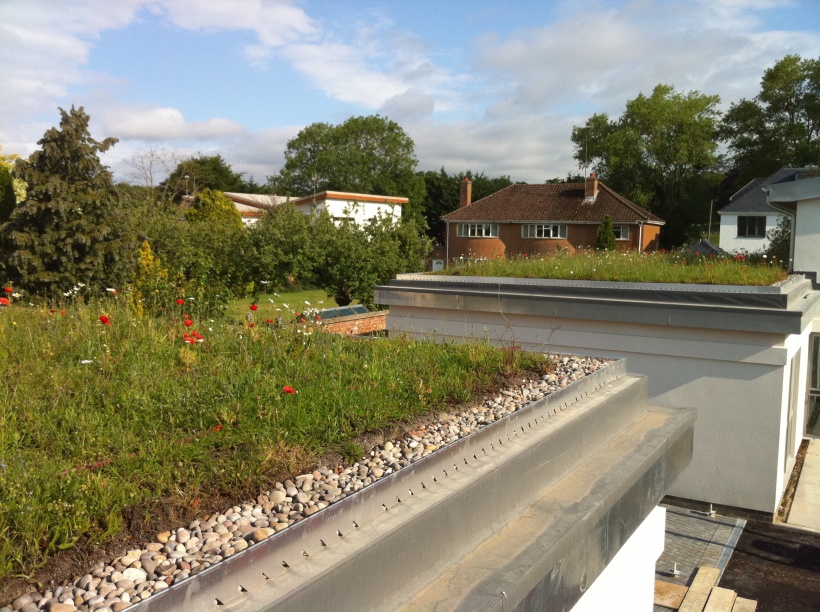
Which landscaping membrane do I need?
Landscaping membranes come in various types, each tailored to specific project needs. Some go beyond the basics, multitasking to control weeds, stabilise the ground, and enhance drainage simultaneously. Let’s delve into the common applications of these membranes and explore recommendations for selecting the most suitable landscaping material for your project.
Understanding the diverse functionalities of these fabrics ensures that you can make informed choices based on the unique requirements of your landscaping endeavours.
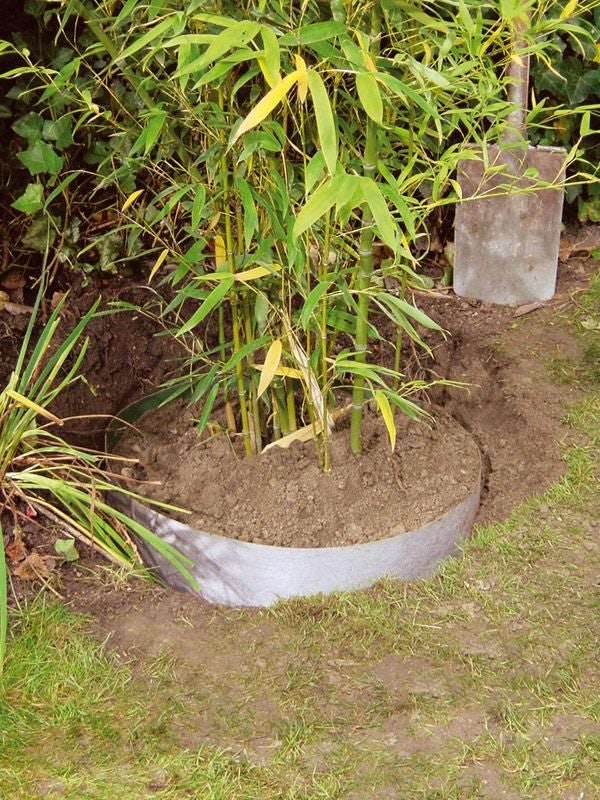
To control weeds
You will need:
Weed control fabric
How it works:
Weed control fabrics are designed to keep weeds from sprouting through the soil. Although they stop weeds from coming through, they continue to let air and water pass through.
Suitable for:
Each product has little differences (so make sure to read the label) but, with that said, you can use weed control fabric to line flower beds and borders or place it under timber decking, block paving and patios.
How to install:
- To put weed control fabric in a flower bed, cut the sheet to the right size and shape, then cut holes where you want the plants to go.
- Once you’ve secured the fabric in place with landscaping pins, cover it over with a thick layer of mulch. This will help plants you have intentionally planted have access to the nutrients in the soil, stopping weeds sprouting up through the protective layer.
Which weed control fabric to choose:
There are several options, depending on your budget.
| Weed control fabric | Description |
| Proweed Control fabric | •Extremely cost-effective and labour-saving. •Made of non-woven polypropylene. •Can be bought in a size to fit your project. •Combined with mulch, bark, decorative stone or gravel for the top layer. •Can be applied to flower borders, under timber decking and for gravel paths and patios (cannot be used under the turf). |
| Weed Control & Landscape Fabric | •For weed control in areas where the land is flat. •Choice of professional landscape gardeners. •Serves as an unbeatable weed growth barrier. •Can give you stable foundations, prevent the mixing of soils and add drainage. •Ideal for patios, block paving and timber decking. |
| DuPont Plantex Cocomat | •Suitable for planting in a new build site. •Finished with aesthetically pleasing natural coconut fibres. |
| Groundtex | •Multipurpose weed control fabric. •Doubles up as a ground stabiliser. •Made of tough woven fabric. •Exceptional strength and tear resistance when utilised underneath below driveways and paths. •Can also be used as a heavy-duty weed barrier. |
To control roots
You will need:
A specialist root barrier
How it works:
A non-permeable root barrier is used vertically to prevent particularly aggressive roots. This includes bamboo, which can affect the rest of a garden or disrupt the structure of a road or pathway. To contain a planted area, use a root barrier by placing it in a circular structure around it.
Suitable for:
Used around aggressive plants where roots may threaten paved areas, roads, lawns, patios or building foundations
How to install:
- You’ll need to grab a shovel and dig a 70cm deep trench running around the diameter of the plant whose roots you wish to control.
- Install your root barrier vertically, lining the inside of the trench including up the sides.
- Fill the trench with soil, making sure to leave a 2cm overlap of root barrier above the surface.

Which root control fabric to choose:
Landscaping Superstore stocks two products that deal with root control.
| Root control fabric | Description |
| Dupont Root Barrier | •One of the strongest products on the market. •This is commonly referred to as advanced fabric that prevents and contains invasive growth, including preventing aggressive plants like bamboo and hypericum from affecting the area. •Encourages the roots to grow downwards and protects them from pollutants. |
| Rootbar (Icopal) | •Suitable for controlling roots on roof gardens and green roofs. •Stops roots from penetrating surfaces, allowing water to enter. •Can be used on flat or sloping roofs. |
For more information on weed control, read our guide to finding out which weed control is the best.
For ground stabilisation and soil separation
You will need:
A strong geotextile membrane. This could be woven, but sometimes a non-woven membrane is suitable to add extra drainage capabilities. Alternatively, use a pre-made gravel grid, as pictured below.
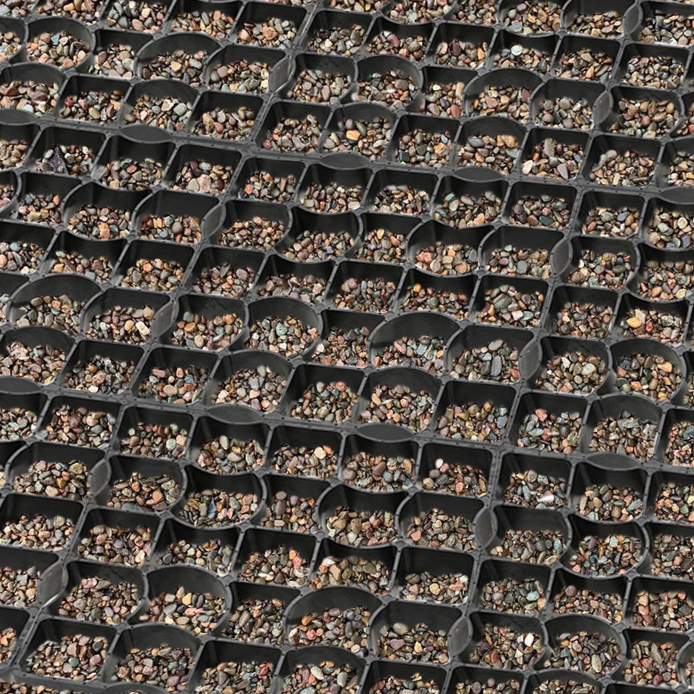
How it works:
Different types of soil can have different consistencies. For example, soil plus rain equals uneven ground and even starts to sink as small particles get washed down in between the larger soil particles.
Geotextile membranes prevent this from happening. They ensure the layers of the soil stay separated, so any hardscaping built on the foundation will be strong and secure.
Suitable for:
Perfect for use under roads or driveways, paths or patios.
How to install:
- Remove large stones or debris from the base as these could cut or tear the fabric.
- Roll out your geotextile over the prepared area, making sure to minimise overlaps.
- Use fixing pegs to secure the geotextile in place, then add a sub-base over it and compact it with a roller.
Which geotextile membrane to choose:
Landscaping Superstore stocks a variety of products that are perfect for ground stabilisation and soil separation.
| Type of geotextile | Description |
| Drivetex | •Professional driveway fabric used specifically for ground stabilisation. •Has excellent filtration and drainage properties. •Any potholes or sinking caused by the settlement of aggregates underneath the soil can be prevented. •Does not lose strength when used below ground, so it’s ideal for areas subject to a lot of stress and strain. |
| Groundtex | •Made of tough woven fabric. •Amazing strength and tear resistance when used below driveways and paths. |
| Earthworx | •An extra heavy-duty, non-woven geotextile. •Used a lot for roads, car parks, foundations and retaining structures. |
| TCS Geotechnics | •Woven and non-woven products. •These are specialist geotechnical suitable for construction and civil engineering industries. |
| Terram | •Famous within the industry, with many people call all geotextiles ‘Terram’. •A non-woven geotextile that’s especially robust - perfect to use even when the potential for installation damage is high. •Withstands high levels of stress and strain without the risk of puncture. |
| Wallbarn | •Widely known for its durability. •Non-woven geotextile products ideal for stabilising soil and sand under patios and decking, as it makes even notoriously unreliable building surfaces more stable. |
For drainage or filtration
You will need:
A non-woven geotextile.
How it works:
A non-permeable root barrier is perfect for letting water through while keeping soil particles out. Ideal for wrapping and protecting soakaway crates and land drains, but not limited to that use, these materials also go beneath domestic patios and block paving bases, keeping the granular layer separate from the soil, and allowing water to drain away freely.
Suitable for:
Suitable for use in soakaway systems and land drains, plus applicable beneath domestic patios and hardscaping.
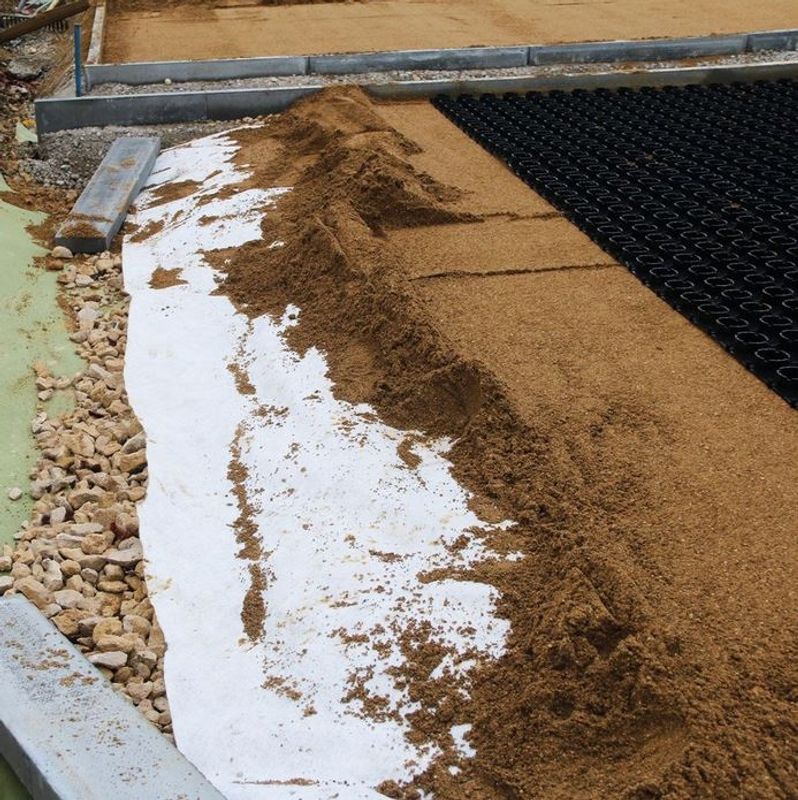
How to install:
- Wrap every side of your crate in the geotextile fabric and fix it in place with staples or strong tape if you want to use non-woven fabrics in a soakaway system.
Which drainage of filtration fabric to choose:
Landscaping Superstore stocks several products that deal specifically with drainage.
| Filtration fabric | Description |
| Draintex | •A standard-duty, non-woven geotextile fabric, featuring excellent drainage and filtration properties. •Perfect for lining trenches during French drain construction and great for wrapping soakaway crates. •Also possible for use as a ground stabilisation membrane in many hard landscaping projects. |
| ACOTex (Plus) Drainage Infiltration Geotextile | •Non-woven geotextile for use in infiltration applications. •Lets water in and out of an ACO StormBrixx system soakaway system. •Prevents entry of sediment into tanks incorporating sediment forebays. •ACOTex Plus is usable with ACOWrap or with a welded geomembrane system. |
| ACOWrap Drainage Geomembrane | •Woven geomembrane. •An impermeable self-install geomembrane using taped joints for non-sensitive attenuation applications. |
| Wallbarn | •Targeted specifically at drainage. •Allows water flow through the soil without any clogging. |
ACO make products specifically for lining soakaway crates. They also supply protective fleece that can shield the geomembrane from mechanical damage.
Do I need a woven or non-woven geotextile?
You certainly need to understand the basic differences between them to ensure you choose the right geotextile fabric for your project. So, should you choose woven or non-woven?
Woven geotextiles (h3)
What are they?
Woven geotextiles are made by weaving polypropylene tapes in a crisscross pattern, ensuring exceptional strength in the fabric.
What they’re used for?
The high tensile strength of the woven geotextiles makes them suitable for use under patios, paths and parking areas.
Advantages vs Disadvantages
Woven geotextiles are robust and cost-effective, coming in at a slightly lower price than non-woven alternatives. Thanks to their added strength, woven geotextiles boast a greater load capacity. However, it’s important to note that they have limited drainage and filtration capabilities compared to their non-woven counterparts, and their strength may diminish over time.
Below, you’ll see the woven membrane on the left and the non-woven counterpart on the right.
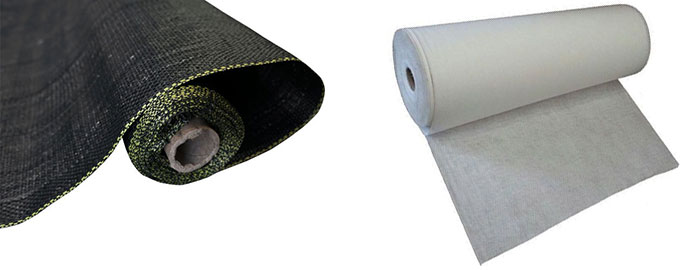
Non-woven geotextiles
What are they?
Non-woven geotextiles are made by thermally bonding polypropylene and finished by using needle punching. This gives a felt-like feel.
What they’re used for?
Non-woven fabrics may have a lower tensile strength than their woven counterparts but are still robust and durable. Their standout feature is their excellent drainage capabilities, making them a top choice for placement beneath driveways and roads. Ideal for scenarios requiring a long-term, stable ground and effective filtration.
Advantages vs Disadvantages
Non-woven fabrics are easy to cut, durable, and strong. They provide excellent drainage and filtration without compromising strength over time, even though they have a lower tensile strength than woven alternatives.
To understand various geotextiles better, delve into our comprehensive guide to geotextiles.
How easy is it to fit landscaping membrane?
Installing landscaping membranes is a breeze, provided you get the right size for your job. To minimize overlaps, opt for a roll that closely matches your project’s dimensions.
For paths, go for a narrow, long roll, like a 1m width and 15m length. If it’s a square area like a patio, consider wider and shorter packs, such as 2m wide and 10m long. Handling large surface areas? Maxi rolls, reaching up to 100m in length and widths up to 4.5m, have got you covered.
Now then, with all that information to hand, head on over to our wide range of landscaping fabrics. You might even find some more gardening products and furniture to help you with your latest landscaping project.




























